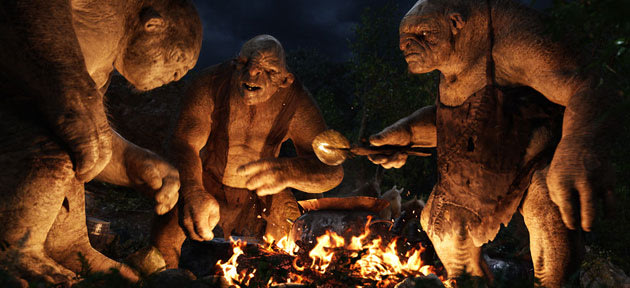‘The Hobbit’ First Look: We’ve seen it, and it’s a welcome return to Middle-earth - It's been nine long years since we last left the realm of Middle-earth, and if you've been dying to return to the world of Hobbits, Dwarves, and Elves, we've got good news for you. "The Hobbit: An Unexpected Journey" takes you right back to the familiar lands of "The Lord of the Rings," and the new movie fits right on the shelf with director Peter Jackson's previous three Tolkien adaptations.

The three Trolls (Photo: Warner Bros. Pictures)
"The Hobbit" is packed with sweeping action, grand vistas, disgusting monsters, stirring music, and goofy Dwarves. The cast features some perfectly chosen new actors and the return of many familiar faces. However, it lacks the dramatic weight of the original trilogy, but that is keeping with the lighter tone of the source book which predated "The Lord of the Rings" by nearly two decades. The only piece that really feels out of place is the new technical innovation that's being introduced with this film: the 48 frames-per-second High Frame Rate photography.
Another fellowship, another quest
"The Hobbit" starts off very much in the same vein as the first LOTR film, "The Fellowship of the Ring." It begins with a long flashback to a war with a powerful enemy, in this case, when the Dwarves of Erebor lost their home in the Lonely Mountain to the fire-breathing dragon Smaug. After an introductory sequence with Ian Holm and Elijah Wood reprising their roles as Bilbo and Frodo Baggins, respectively, the movie jumps back sixty years to the young Bilbo, now played by Martin Freeman.
Just like before, Gandalf the wizard (once again played with twinkly-eyed gravity by Ian McKellen) enlists the naïve and sheltered Hobbit to leave the comforts of his hole in the ground and embark on a epic quest. But where the "Fellowship of the Ring" had an eclectic collection of races, Bilbo joins a pack of thirteen Dwarves. There are actually too many of them to really get a sense of them all as distinct personalities, but a few do stand out, specifically their leader, the dark and dashing Thorin Oakenshield
Martin Freeman: Born to be a Hobbit
Of course, the success of "The Hobbit" as a film rides predominantly on the shoulders of the man playing the title character, and Martin Freeman doesn't disappoint. A veteran of British TV -- including the original "The Office" and the current "Sherlock" -- Freeman hasn't had much luck in Hollywood movies until now. But he really is perfectly cast, recalling Ian Holm's portrayal of Bilbo from the originals without trying to imitate it. Freeman gets the humor of the character, and he really shines during the integral scene where Bilbo faces off against Gollum, once again portrayed (via motion capture) by Andy Serkis.
Trolls and goblins and orcs (oh my!)
The first "Rings" movie had two memorably scary monsters hunting down the heroes: the black riders, aka the Nazgul, and the Uruk-Hai. The bad guys in "The Hobbit" are as genuinely frightening, but they are plenty gross. Bilbo has to face a trio of phlegmy Trolls, an army of goblins lead by a deformed king, and a one-armed orc with a vendetta against Thorin. Advances in CGI make these characters much more life-like and expressive than some of the creatures in the original trilogy to the point where it's almost impossible to tell what was created in the computer and what was done through makeup.
Higher frame rate definitely changes the experience
The biggest technical difference between "The Hobbit" and the old films is that it was shot and in some theaters will be projected in the new 48 fps (frames per second) 3D system. The new cameras shoot twice as many individual images than traditional film methods, with the goal being a smoother and more immersive experience. And while the new presentation does make the 3D easier on your eyes, losing the traditional "film flicker" does fundamentally change how you view the movie.
It takes a while to adjust to the effect (the first few scenes almost looked like they were in fast motion), and even after you get used to the effect it never does look like "a movie" as we've come to understand it. Some shots do create an astonishing effect like you really are there, but others just look like you're watching a really expensive HDTV. It was a worthwhile experiment to try making a film in the new system, but theatrical features are probably not the best format for the technology.
Oscar chances seem unlikely
The final chapter of the original trilogy, "The Return of the King," won 11 Academy Awards, including Best Picture, tying the record for most wins shared by "Ben-Hur" and "Titanic." While "The Hobbit" will surely be considered for technical awards for visual effects, makeup, and sound, it's safe to say it won't be in the running for the major awards this time out. This one lacks the truly powerful emotional moments of the earlier films, and while the performances are solid, none are showy enough to grab any nominations.
This film is the first chapter of a new trilogy, though. Originally, Peter Jackson intended to split the book into two films, but earlier this year decided there was enough material for a third installment. There is a fair amount of time in this movie setting up the villains for the later chapter, and while it does end on something of a cliffhanger, it still feels like a complete story in and of itself. ( Movie Talk )
Blog : Specific Actions
No comments:
Post a Comment